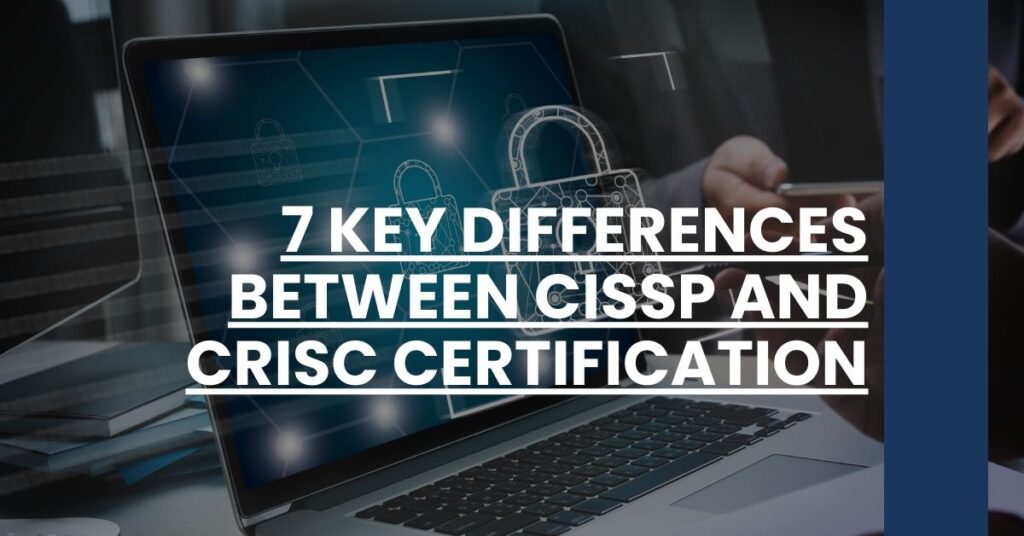Are you torn between pursuing CISSP or CRISC for bolstering your career in information security? The choice is pivotal and often perplexing.
In this concise exploration, we delineate the CISSP vs CRISC—two certifications with distinct paths and purposes within the realm of cybersecurity.
Unveil which aligns with your career trajectory and the specific competencies each one endorses.
- 1. Accrediting Bodies and Their Focus
- 2. Core Objectives of Each Certification
- 3. Exam Requirements and Structure
- 4. Domains Covered by CISSP and CRISC
- 5. Career Implications and Job Roles
- 6. Continuing Education and Recertification
- 7. Global Recognition and Demand
- Related Topic: Complementary Certifications
- Related Topic: Salary Expectations
- Conclusion: Making the Right Choice for Your Career
1. Accrediting Bodies and Their Focus
When it comes to professional certifications, the two heavyweight champions are CISSP and CRISC. But who hands out these coveted titles? CISSP is the brainchild of the International Information System Security Certification Consortium, or (ISC)²—a name synonymous with a robust, all-encompassing approach to information security. On the flip side, CRISC is cradled in the arms of ISACA, an entity revered for its stringent focus on IT risk management and governance.
- (ISC)²’s Arena: Their certification spectrum is expansive, designed to sculpt professionals skilled in various aspects of information security—from designing cybersecurity programs to managing complex security operations.
- ISACA’s Domain: They concentrate on the nitty-gritty of risk management, offering credentials for those who wish to master the art of identifying and managing IT-related business risks.
Both bodies are titans of the industry; however, your career path might veer more towards the broader cybersecurity landscape championed by (ISC)²’s CISSP or the focused risk strategy and evaluation preached by ISACA’s CRISC. Weighing the scale between CISSP’s broad security coverage and CRISC’s specialized enterprise lens will be dependent on your long-term career aspirations.
2. Core Objectives of Each Certification
As you embark on the journey to elevate your professional standing, understanding the core objectives behind CISSP and CRISC is crucial. Think of CISSP as your golden ticket to a deeper understanding of both the technical and managerial facets of cybersecurity. From security architecture to disaster recovery planning, this certification aims to strengthen your leadership and operations capabilities across eight domains.
On the contrary, CRISC’s laser-focused aim is to crown you as a maestro of IT risk management. When it comes to identifying threats, evaluating the effectiveness of various controls, and helping your organization reach its goals while mitigating IT risk, CRISC is the name of the game.
As you ponder the road ahead in the grand scheme of CISSP vs CRISC, reflect upon whether you desire extensive cybersecurity knowledge or specialized risk-focused expertise.
3. Exam Requirements and Structure
To earn these renowned accolades, you must conquer their exams, each a test of wit and will. The CISSP exam beckons you with a mix of question formats, delivered through an adaptive testing model for its English version or a linear experience in other languages. It demands at least five years of hardcore field experience or four years accompanied by a relevant college degree or approved credentials.
CRISC, on the other hand, invites you to a standardized testing environment—courtesy of authorized PSI centers or through remote proctoring—with three years of experience in the domain of risk management and control. Like a knight ready for battle, you’d do well to arm yourself with the structure and requirements of both exams to decide which dragon you’re ready to slay.
4. Domains Covered by CISSP and CRISC
The crux of CISSP vs CRISC often boils down to the domains they cover—your battlefield of expertise. CISSP’s expansive realm includes territories such as Security and Risk Management, Asset Security, and the wizardry of Software Development Security.
- Risk, Oh My!: It all starts with a solid grasp of risk identification and mitigation.
- Protect Thy Assets: You’ll learn to safeguard the virtual treasure trove of data that organizations hold dear.
- Crafting Secure Software: Being able to contribute to or oversee secure software development is more art than science.
On the contrasting end, CRISC kingdoms span IT Risk Assessment, Risk Response and Reporting, and the governance to maintain order in the digital realm.
- Assessment Acuity: Because knowing is half the battle, learning to assess IT risk is key.
- A Plan of Attack: Crafting strategies to respond to identified risks empowers you to protect your enterprise.
- Telling the Tale: Effectively reporting on risk ensures that decision-makers are informed.
Deciphering these domains is your strategic map in the quest of choosing between a career fortified by CISSP’s security versatility or the specialized risk governance crusade led by CRISC.
5. Career Implications and Job Roles
CISSP and CRISC not only mold you into an expert; they are also your ladders to different echelons in the cybersecurity hierarchy. With CISSP, anticipate unlocking doors to leadership and advisory roles. Envision yourself as a Security Consultant, a Chief Information Security Officer (CISO), or even a Security Architect, with companies seeking your wide-ranging expertise.
CRISC, in contrast, positions you ideally for niche roles where risk is the name of the game. Risk Managers, Compliance Professionals, and Control Analysts are members of this exclusive club, where your specialized knowledge makes you central to organizational strategy and risk decision-making.
Before you leap towards either certification, consider the long game. Where do you see yourself? Coordinating a broad spectrum of security efforts, or steering the ship through the ever-evolving seas of IT risks and controls? The roles you aspire to can greatly influence whether CISSP or CRISC aligns with your professional narrative.
6. Continuing Education and Recertification
Beyond the triumph of passing your certification exams lies the ongoing journey of professional development. Both CISSP and CRISC require a commitment to continuous learning—a critical aspect for staying relevant in the ever-evolving realm of information security.
- Earn Your Credits: To keep either certification active, you need to accumulate 120 Continuing Professional Education (CPE) credits over a three-year period.
- Stay Engaged: This process ensures you remain engaged with the latest trends, tools, and techniques in your field.
- Contributions Count: Active participation in the community, whether through attending webinars, seminars, or other educational events, counts towards your CPE credits.
By prioritizing your ongoing education, you’re not only adhering to certification requirements—you’re also sharpening your skills and staying ahead in the competitive field of cybersecurity.
7. Global Recognition and Demand
Whether you’re leaning towards CISSP or CRISC, rest assured that both certifications boast significant clout in the global job market.
- CISSP: As a CISSP holder, you’re recognized as a comprehensive security expert, valued by employers worldwide. This certification is not only a mark of excellence but also a green signal for recruiters that you possess a substantial command over a broad swath of security practices.
- CRISC: CRISC certification signals to potential employers your specialized skills in IT risk management—an arena of growing concern for global businesses striving to mitigate operational uncertainties.
The balance between supply and demand for CISSP and CRISC certified professionals tilts in favor of the certified individual. Enhanced marketability, job security, and potential for advancement are well within reach, reflecting the deep-seated respect the industry has for these qualifications.
Related Topic: Complementary Certifications
In your quest to stay atop the industry ladder, why stop at one certification? A strategic combination can further elevate your prowess.
Pairing CISSP with complementary certifications not only broadens the horizon but fortifies your resume:
- CISM (Certified Information Security Manager): Hones in on governance and strategic risk management.
- CISA (Certified Information Systems Auditor): Ideal for those who want to add system auditing to their toolkit.
- CompTIA Security+: Provides a foundation for hands-on security skills across various security domains.
Similarly, CRISC pairs well with credentials that enhance its risk-based focus:
- CISA (Certified Information Systems Auditor): Again, because understanding system audits can enrich a risk management role.
- CGEIT (Certified in the Governance of Enterprise IT): Perfect for those aiming to steer IT governance at a senior level.
Picking the right certification to complement either CISSP or CRISC enhances your professional narrative in the information security and risk management spheres.
Related Topic: Salary Expectations
Discussing certifications without mentioning the financial rewards is like painting half a picture. Let’s bring it into full view:
- CISSP: Professionals with this certification report an average annual salary hovering around the mark of $120,000.
- CRISC: Those equipped with CRISC credentials enjoy an average annual earnings of approximately $107,968.
These figures aren’t merely numbers; they represent the tangible value that the industry places on certified expertise. Clearly, professionals with CISSP or CRISC are not only desired for their skills but also rewarded for their proven competency.
Conclusion: Making the Right Choice for Your Career
As you sift through the CISSP vs CRISC debate, it’s crucial to align your professional goals with the right certification. Contemplate your aspirations, the job roles you’re eyeing, and how you want to sculpt your career in information security.
Consider CISSP if you’re aiming for a broad command over security practices along with an impressive title like CISO. On the other hand, CRISC will be your lighthouse if you’re navigating the specific sea of IT risk management.
Armed with this knowledge, you’re now well-equipped to choose the certification that best matches not only your current skills and experiences but also your vision for the future. Whether you choose CISSP, CRISC, or a strategic combination of the two, the journey ahead is promising. Your investment in education today is the cornerstone of your professional success tomorrow.

